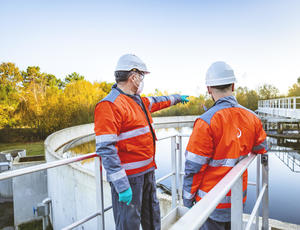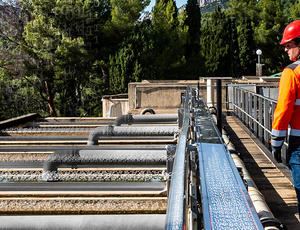Biobed® Advanced (EGSB): Tall, slender reactor for anaerobic wastewater treatment. Converts organic pollutants to biogas (mainly CH4, CO2) using bacteria. Supports energy transition and reduces carbon footprint.
Overview
The principle of anaerobic treatment is the utilization of anaerobic bacteria (biomass) to convert organic pollutants or chemical oxygen demand (COD) into biogas in an oxygen-free environment.
This patented design handles high volumetric loading rates while maintaining high treatment efficiency, and is ideal for applications with space constraints. In addition, biogas produced by anaerobic treatment can be used as an environmentally friendly, renewable energy source. An anaerobic plant can be energy neutral or even an energy producer.
How does Biobed® Advanced (EGSB) work?
In the anaerobic process, bacteria form granules with a high density that settle well in the reactor to create a high concentration of biomass in the reactor. The high concentration of biomass allows for high volumetric loading rates that result in compact treatment systems.
The Biobed® Advanced system represents a significant leap forward in sustainable wastewater treatment. At high reactor loading rates, this innovative technology not only matches the sludge retention capabilities of traditional UASB systems but also achieves comparable COD removal efficiencies, marking a new era in eco-friendly water management.
Our pilot and full-scale plants consistently demonstrate a stable and reliable increase in granular sludge, showcasing the system's ability to naturally enhance its own performance over time. With Biobed Advanced EGSB systems operating worldwide, we're witnessing a global shift towards more sustainable industrial practices.
The system's ecological impact is particularly evident in our largest installation - 3 reactors with a total of 9,000 cubic meters at a Chinese paper mill, processing an impressive 183 tons of COD daily. This high-capacity system exemplifies superior COD removal efficiencies, translating to significant reductions in chemical usage and substantially lowered energy demands for aerobic post-treatment. These improvements directly contribute to decreased carbon footprints and reduced environmental impact.

Sustainability and economic efficiency hand-in-hand
Full-scale plant experiences consistently show lower initial investment costs, reduced overall operating expenses, and minimal operator intervention compared to conventional anaerobic systems. This combination of ecological and economic benefits positions the Biobed® Advanced system as a cornerstone technology in the global movement towards circular economy practices and industrial sustainability.
By choosing this system, industries are not just treating wastewater; they're actively participating in ecological transformation, conserving resources, and paving the way for a greener, more sustainable future.
Features and benefits
Enhanced capacity
- The settler can handle higher liquid and gas upflow velocities, reducing the required settler area in the reactor.
Compact design
- Requires less construction material and results in a smaller more compact footprint.
Versatile dimensions
- The standard design fits round and square tanks, with heights of up to 20 meters.
Standardized efficiency
- A robust and very effective effluent collection system with submersed pipes completes the design standardization; using standard stainless steel plates and modular design for construction results in cost efficient fabrication of the key equipment for the process.
Optimized transport
- Transportation costs are further reduced by using optimised equipment dimensions which fit nicely in standard 40-feet sea containers.
Applications
Services
Resources & Product range
Biothane® Advanced (UASB)
The Biothane® Advanced UASB (Upflow Anaerobic Sludge Blanket) is a groundbreaking, high-efficiency anaerobic treatment system for industrial wastewater. As the world's most widely adopted granular biomass technology, it has established itself as the go-to solution in the food and beverage sector, renowned for its versatility and dependable performance across diverse applications.
Biobed® EBS (EGSB)
The Biobed® EBS (EGSB) combines advanced EGSB technology with an innovative External Biomass Separation system, offering a high-performance anaerobic wastewater treatment solution. This unique design facilitates easy maintenance and cleaning, making it ideal for applications prone to scaling or precipitation. Particularly well-suited for the recycled paper industry, the Biobed® EBS addresses specific challenges in this sector while maintaining efficient wastewater treatment.
Biobed® ATOM
ATOM stands for Anaerobic Technologies On the Move. It incorporates in a pre-engineered standardised compact unit two main anaerobic Biothane technologies such as Biobed Advanced EGSB and Biothane Advanced UASB.
Contact
Since the introduction of the Biobed EGSB technology we have installed more than 300 systems globally. Some of these installations have been in operation for more than 30 years already. This is a clear proof and demonstration that this high loaded anaerobic granular biomass system shows reliable, long term, superior COD removal efficiencies, which results in reduced operating cost for power and chemicals and substantially reduces aerobic post treatment power and surplus sludge treatment and disposal costs.

Michel Otten
Technical Manager at Biothane
Contact Michel through his LInkedIn account
FAQ about Biobed®Advanced EGSB
Is biogas safe?
Yes, biogas is in principle safe when properly produced and handled. Biogas is a renewable energy source generated through anaerobic treatment of organic waste or wastewater. During this process, anaerobic bacteria break down biomass in the absence of oxygen, resulting in methane production. This natural gas-like biogas is a valuable by-product of anaerobic wastewater treatment and can be used for energy recovery.
The safety of biogas is ensured through proper technical system design that allows for safe design and operation of biogas production facilities. These systems typically use advanced technologies, such as granular sludge reactors, which optimize the anaerobic treatment process. When managed correctly, biogas production from wastewater treatment plants is a safe and environmentally friendly method of generating renewable energy.
However, like any fuel, biogas must be handled with care. Proper safety measures, including gas detection systems, pressure relief valves, and regular maintenance, are essential to ensure the safe operation of biogas facilities. When these precautions are in place, biogas production offers a safe and sustainable solution for waste management and energy generation.
Is biogas environmentally friendly?
Biogas production through anaerobic wastewater treatment is a sustainable process that offers significant environmental benefits. By harnessing the power of anaerobic bacteria to break down organic waste and biomass, this method effectively manages waste while generating renewable energy.
The anaerobic treatment process used in biogas production reduces the release of harmful greenhouse gasses that would otherwise occur if the organic matter decomposed naturally. Instead, it captures methane, a potent greenhouse gas, and converts it into usable energy. This energy recovery process helps offset the use of fossil fuels, thereby reducing overall carbon emissions.
Furthermore, biogas production from wastewater treatment plants helps to close the loop in waste management. It transforms what was once considered a disposal problem into a valuable resource. The use of advanced technologies like granular sludge reactors enhances the efficiency of this process, maximizing methane production and energy output.
By combining waste treatment with renewable energy generation, biogas production contributes to a more circular economy and supports global efforts to combat climate change. It's an environmentally friendly solution that addresses multiple ecological challenges simultaneously.
Case Studies

To help our client meet new discharge legislation and environmental commitments at their Izmir plant in Turkey our team implemented a cutting-edge wastewater treatment system featuring patented technologies to produce valuable biogas. Beyond treating wastewater for potential reuse, our solutions generate renewable energy, reducing the plant's carbon emissions by 17% and providing significant savings on natural gas consumption. By reducing strain on local freshwater resources and minimizing the factory's environmental footprint, Pınar Süt can confidently pursue its sustainability policy while benefiting from substantial cost savings and improved operational efficiency.




